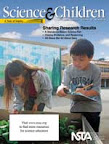Sharing research results of play dough comparison
By Peggy Ashbrook
Posted on 2011-04-10
 Children in my preschool love to cook, and in some ways cooking is much like science learning. We feel the ingredients, measure them, follow a procedure to (hopefully) replicate the results of others, and make observations as we mix and apply heat. We get to eat our work, something we do not do in science activities, and we collect data (was it yummy, too dry, not enough salt) and share the results (actual product and written observations) with others (classes or families).
Children in my preschool love to cook, and in some ways cooking is much like science learning. We feel the ingredients, measure them, follow a procedure to (hopefully) replicate the results of others, and make observations as we mix and apply heat. We get to eat our work, something we do not do in science activities, and we collect data (was it yummy, too dry, not enough salt) and share the results (actual product and written observations) with others (classes or families).
 Collecting data and analyzing it can be part of a non-edible cooking-as-science activity: making play doughs. The April 2011 Early Years column shares the steps for making play dough cookery into a science activity, including observing the nature of the ingredients, measuring, mixing to make a change, evaluating the product, and recording the data .
Collecting data and analyzing it can be part of a non-edible cooking-as-science activity: making play doughs. The April 2011 Early Years column shares the steps for making play dough cookery into a science activity, including observing the nature of the ingredients, measuring, mixing to make a change, evaluating the product, and recording the data .
There are many play dough recipes collected online and in books.
Online
Here are some sites to get you started, but note that I have not made all the recipes on these sites. Check for allergies. Do try them first yourself at home, and plan for safety by having the children wear goggles (salt in the eyes hurts!) and using a wooden cover for an electric skillet to protect from burns.
- http://teachnet.com/lessonplans/art/play-dough-options-do-it-yourself-recipes-for-kids/
- http://www.playdoughrecipe.org/
- http://www.hummingbirded.com/play-doh-recipes.html
- http://www.easy-kids-recipes.com/play-dough-recipes.html
 In print
In print
A classic from the 1960’s, Mud Pies and Other Recipes by Marjorie Winslow with illustrations by Erik Blegvad, is a cookbook for imaginative play—use it outdoors to make pretend food with natural materials.
Mudworks: Creative Clay, Dough and Modeling Experiences by MaryAnn F. Kohl. Look for real recipes you need in the cooking, no cooking, air dry, bake dry, edible, caution, and “adult supervision always necessary” categories.
Children are discerning consumers of play materials, but not all have the same preferences. Have your students record their observations on a chart (see an example at www.nsta.org/SC1104) and see which play dough recipe they want to make again. Do you have a favorite recipe or cautionary tale to share?
Peggy
Disclaimer: The views expressed in this blog post are those of the author(s) and do not necessarily reflect the official position of the National Science Teaching Association (NSTA).


